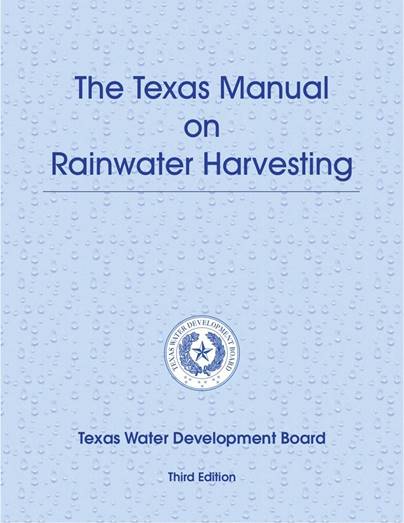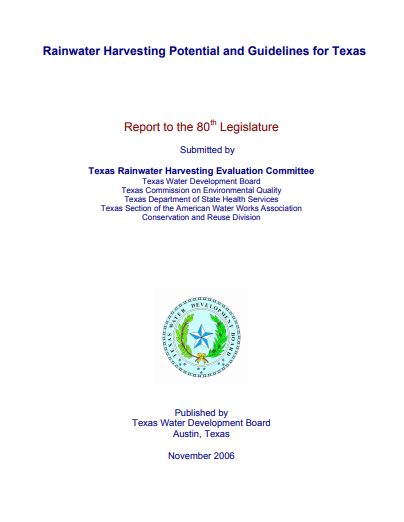Due to a dry climate and water supply issues, Texas has promoted rainwater harvesting and has passed many laws and regulations that directly pertain to the practice of rainwater harvesting and other auxiliary water practices. We have therefore given Texas a rating of “A” for the following reasons:
- Texas passed a law in 2001 that provides sales tax exemption for rainwater harvesting system components.
- Texas has an explicit law that states that Homeowner Associations cannot prohibit the practice of rainwater harvesting.
- Texas has explicit laws that details the requirements of a rainwater harvesting system.
- Many cities in Texas offer incentives and rebates for the installation of a rainwater harvesting system.
- Agencies in Texas have developed publications that offer guidance for the installation of rainwater harvesting systems.
- Texas does not prohibit the use of rainwater harvesting systems for potable use.
Basis of Texas Water Law
Texas courts divide water into two legal classes: groundwater and surface water. As for surface water rights, Texas recognizes both riparian and prior-appropriation doctrines.
Texas Water Law – Wonderful synopsis and history of water law in Texas by the Texas State Historical Association
Texas Water Law – Brief explanations about the law related to the different classes of water in Texas
Texas Water Code – Code that codifies the water-related laws of Texas
Texas Water Law Timeline – Interactive timeline of general water-related laws by the Legislative Reference Libary of Texas
Texas Administrative Code
Rainwater Harvesting Specific Rules
RULE §290.44 (j) states:
If a structure is connected to a public water supply system and has a rainwater harvesting system, the structure must have appropriate cross-connection safeguards in accordance with subsection (h)(1) of this section.
Subsection (h)(1) states that no water connection from any public drinking water supply system shall be allowed to any residence or establishment where an actual or potential contamination hazard exists unless the public water facilities are protected from contamination.
- A privately owned rainwater harvesting system with a capacity of more than 500 gallons that is connected to a public water system for a back-up supply shall have a backflow prevention assembly or an air gap installed at the storage facility for the harvested rainwater to ensure physical separation between the rainwater harvesting system and the public water system.
- At each residence or facility where water from a rainwater harvesting system is used for potable purposes and there is a connection to a public water system, the public water system shall ensure that the rainwater harvesting system is installed and maintained by a master plumber or journeyman plumber licensed by the Texas State Board of Plumbing Examiners and who holds an endorsement issued by the Texas State Board of Plumbing Examiners as a Water Supply Protection Specialist.
- A person who intends to connect a rainwater harvesting system to a public water system must give written notice of that intention to the municipality or the owner or operator of the public water system in which the rainwater harvesting system is located.
- The public water system used as a back-up supply for the rainwater harvesting system may be connected only to the water storage tank and may not be connected to the plumbing of a structure.
Graywater Reuse Specific Rules
Treatment and Disposal of Greywater
The TCEQ has adopted the changes to the Chapter 210 (Use of Reclaimed Water) of the TAC in accordance with HB 2661 pertaining to graywater. These changes became official January 6, 2005.
TCEQ approved amendments to Chapter 285 (On-site Sewage Facilities) of the TAC in accordance with HB 2661 pertaining to graywater.
General Provisions for On-Site Sewage Facilities
Texas Property Code
RULE §202.07 states:
A property owners’ association may not include or enforce a provision in a dedicatory instrument that prohibits or restricts a property owner from installing rain barrels or a rainwater harvesting system;
This section does not require a property owners’ association to permit a rain barrel or rainwater harvesting system to be installed in or on property if the property is:
- owned by the property owners’ association;
- owned in common by the members of the property owners’ association; or
- located between the front of the property owner’s home and an adjoining or adjacent street;
This section does not require a property owners’ association to permit a rain barrel or rainwater harvesting system to be installed in or on property if the barrel or system:
- is of a color other than a color consistent with the color scheme of the property owner’s home; or
- displays any language or other content that is not typically displayed by such a barrel or system as it is manufactured
This section does not restrict a property owners’ association from regulating the size, type, and shielding of, and the materials used in the construction of, a rain barrel, rainwater harvesting device, or other appurtenance that is located on the side of a house or at any other location that is visible from a street, another lot, or a common area if the restriction does not prohibit the economic installation of the device or appurtenance on the property owner’s property; and there is a reasonably sufficient area on the property owner’s property in which to install the device or appurtenance.
This section does not apply to a property owners’ association that:
- is located in a municipality with a population of more than 175,000 that is located in a county in which another municipality with a population of more than one million is predominantly located; and
- manages or regulates a development in which at least 4,000 acres of the property is subject to a covenant, condition, or restriction designating the property for commercial use, multifamily dwellings, or open space.
This law also promotes composting, efficient irrigation, and drought-resistant landscaping.
Texas Government Code
SECTION §447.004(c) states:
Any procedural standard established under this section must be directed toward specific design and building practices that produce good thermal resistance and low infiltration and toward requiring practices in the design of mechanical and electrical systems that maximize energy and water efficiency. The procedural standards must address, as applicable:
- insulation;
- lighting;
- ventilation;
- climate control;
- water-conserving fixtures, appliances, and equipment or the substitution of non-water-using fixtures, appliances, and equipment;
- water-conserving landscape irrigation equipment;
- landscaping measures that reduce watering demands and capture and hold applied water and rainfall, including landscape contouring, including the use of berms, swales, and terraces; and the use of soil amendments that increase the water-holding capacity of the soil, including compost;
- rainwater harvesting equipment and equipment to make use of water collected as part of a storm-water system installed for water quality control;
- equipment for recycling or reusing water originating on the premises or from other sources, including treated municipal effluent;
- equipment needed to capture water from nonconventional, alternate sources, including air conditioning condensate or graywater, for nonpotable uses;
- metering equipment needed to segregate water use in order to identify water conservation opportunities or verify water savings;
- special energy requirements of health-related facilities of higher education and state agencies; and
- any other item that the state energy conservation office considers appropriate.
The procedural standards adopted under this section must require that:
- on-site reclaimed system technologies, including rainwater harvesting, condensate collection, or cooling tower blow down, or a combination of those system technologies, for potable and nonpotable indoor and outdoor water use be incorporated into the design and construction of each new state building with a roof area measuring at least 10,000 square feet; and any other new state building for which the incorporation of such systems is feasible; and
- rainwater harvesting system technology for potable and nonpotable indoor and outdoor water use be incorporated into the design and construction of each new state building with a roof area measuring at least 50,000 square feet that is located in an area of this state in which the average annual rainfall is at least 20 inches.
SECTION §580.004 states:
- Each municipality and county is encouraged to promote rainwater harvesting at residential, commercial, and industrial facilities through incentives such as the provision at a discount of rain barrels or rebates for water storage facilities.
- The Texas Water Development Board shall ensure that training on rainwater harvesting is available for the members of the permitting staffs of municipalities and counties at least quarterly. Each member of the permitting staff of each county and municipality located wholly or partly in an area designated by the Texas Commission on Environmental Quality as a priority groundwater management area under Section 35.008, Water Code, whose work relates directly to permits involving rainwater harvesting and each member of the permitting staff of each county and municipality with a population of more than 10,000 whose work relates directly to permits involving rainwater harvesting must receive appropriate training regarding rainwater harvesting standards and their relation to permitting at least once every five years. Members of the permitting staffs of counties and municipalities not located wholly or partly in an area designated by the Texas Commission on Environmental Quality as a priority groundwater management area under Section 35.008, Water Code, whose work relates directly to permits involving rainwater harvesting and members of the permitting staffs of counties and municipalities with a population of 10,000 or less whose work relates directly to permits involving rainwater harvesting are encouraged to receive the training. The Texas Water Development Board may provide appropriate training by seminars or by videotape or functionally similar and widely available media without cost.
- A municipality or county may not deny a building permit solely because the facility will implement rainwater harvesting. However, a municipality or county may require that a rainwater harvesting system comply with the minimum state standards established for such a system.
- Each school district is encouraged to implement rainwater harvesting at facilities of the district.
Texas Rainwater Harvesting Guidance Documents
The Texas Manual on Rainwater Harvesting, Third Edition, 2005. TWDB Publication.
The manual serves as a primer on the basics of residential and small-scale commercial rainwater harvesting systems design. It is intended to serve as a first step in considering options for constructing a rainwater harvesting system or implementing a harvesting program.
Rainwater Harvesting Potential and Guidelines for Texas, Report to the 80th Legislature, Texas Rainwater Harvesting Evaluation Committee.
The report to the Texas Legislature presents a narrative discussion, associated maps, illustrations, key findings and recommendations on the potential benefits and advantages of rainwater harvesting in Texas.
Texas Law Timeline
2015 – 84th Legislature
This bill expands the allowable uses of graywater and alternative onsite water to include indoor uses such toilet and urinal flushing for graywater.
It defines “alternative onsite water” as rainwater, air-conditioner condensate, foundation drain water, storm water, cooling tower blowdown, swimming pool backwash and drain water, reverse osmosis reject water, or any other source of water considered appropriate by the commission.
2011 – 82nd Legislature
One of the most far-reaching and comprehensive pieces of legislation regarding rainwater harvesting. Among its provisions:
- Financial institutions may consider making loans for developments that will use harvested rainwater as the sole source of water supply.
- Rainwater harvesting system technology for potable and non-potable indoor use and landscape watering is required to be incorporated into the design and construction of each new state building with a roof measuring at least 50,000 square feet that is located in an area of the state in which the average annual rainfall is at least 20 inches.
- Rules regarding the installation and maintenance of rainwater harvesting systems that are used for indoor potable purposes and connected to a public water supply system are required to be developed, prior to this bill it could only be used for non-potable purposes. The rules must include criteria to ensure that safe drinking water standards are met and the water does not come in contact with the public water supply at a location off of the property.
- A person who intends to connect a rainwater harvesting system to a public water supply system for potable purposes is required to give written notice to the municipality or the owner or operator of the public water supply system. A municipality or public water supply system may not be held liable for any adverse health effects allegedly caused by the consumption of water collected by a rainwater harvesting system that is connected to a public water supply system and is used for potable purposes if the municipality or the public water supply system is in compliance with the sanitary standards for drinking water.
- Each municipality and county is encouraged to promote rainwater harvesting at residential, commercial, and industrial facilities through incentives such as the provision at a discount of rain barrels or rebates for water storage facilities. The Texas Water Development Board (TWDB) is required to ensure that training on rainwater harvesting is available for the members of the permitting staffs of municipalities and counties at least quarterly. School districts are strongly encouraged to implement rainwater harvesting systems.
- A municipality or county is prohibited from denying a building permit solely because the facility will implement rainwater harvesting.
This bill changed the language from HB 4 / SB 3 (2007) to remove the phrase, “the rainwater harvesting system may be used only for non-potable indoor use.”
Now the regulation states that if a structure is connected to a Public Water Supply and has a rainwater harvesting system for indoor use, the structure must have appropriate cross-connection safeguards and a person who installs and maintains RWHS that are connected to a Public Water Supply and are used for potable purposes must be licensed by a master plumber or journeyman plumber and hold an endorsement issued by the board as a water supply protection specialist…
2007 – 80th Legislature
Multi-point bill dealing with water conservation issues in Texas.
Also requires a structure connected to a public water supply system and has a rainwater harvesting system for indoor use, the structure is required to have appropriate cross-connection safeguards and the rainwater harvesting system may be used only for nonpotable indoor purposes.
2005 – 79th Legislature
The Texas Water Development Board shall establish a Rainwater Harvesting Evaluation Committee to study the feasibility of using rainwater as a source of water supply. The committee shall provide a report to the lieutenant governor and the speaker of the house of representatives.
The final report was submitted to the Texas Legislation in November 2006.
2003 – 78th Legislature
Effective September 1, 2003; Section 202, Property Code, is amended by adding that a property owners’ association may not include or enforce a provision in a dedicatory instrument that prohibits or restricts a property owner from installing rain barrels or a rainwater harvesting system.
Effective September 1, 2003; Section 26.0311, Water Code, is amended to read “graywater” means wastewater from clothes washing machines, showers, bathtubs, handwashing lavatories, and sinks that are not used for disposal of hazardous or toxic ingredients.
Effective January 6, 2005; Chapter 210 (Use of Reclaimed Water) and Chapter 285 (On-site Sewage Facilities) are amended to incorporated the proposed changes introduced by HB 2661.
2001 – 77th Legislature
SB 2
Texas currently faces many water challenges. The 75th Texas Legislature enacted a major water planning bill, S.B. 1, in 1999. S.B. 2 addresses the implementation and financing of the water strategies and recommendations identified in the last four years by Texas’ 16 regional water planning groups.
It gave local taxing entities authority to exempt all or part of the assessed value of property on which water conservation modifications such as rainwater harvesting are made. It also exempted all equipment used for rainwater harvesting from state sales tax.
Texas City Specific Regulations
Water Wells and Rain Water Harvesting Systems, with a combined container capacity exceeding 3000 gallons, must be registered with the City of Wichita Falls Public Works Department.
Regardless of size, all rainwater harvesting systems are subject to the requirements for storage tank compliance and screening described herein; however, no permit shall be required for a rainwater harvesting system that conveys water to an above ground storage tank, such as a rain barrel, for gravity flow (hose flow) irrigation distribution only, if the system consists of one or more storage tanks that cumulatively hold 400 gallons or less in volume. Each owner of a rainwater harvesting system that meets these requirements shall register each system with the Chief Building Official.
Texas Rainwater Harvesting Rebates & Incentives
Our rainwater harvesting rebate page has more information about the various cities and other agencies that offer these rebates in Texas,
Help Us Make This Guide Better
If you have any information about regulations, laws, and rebates for auxiliary water supplies (rainwater, graywater, reclaimed water, etc) in your state, please use the contact form below and share with us. Links to online sources are especially helpful. Thanks!




